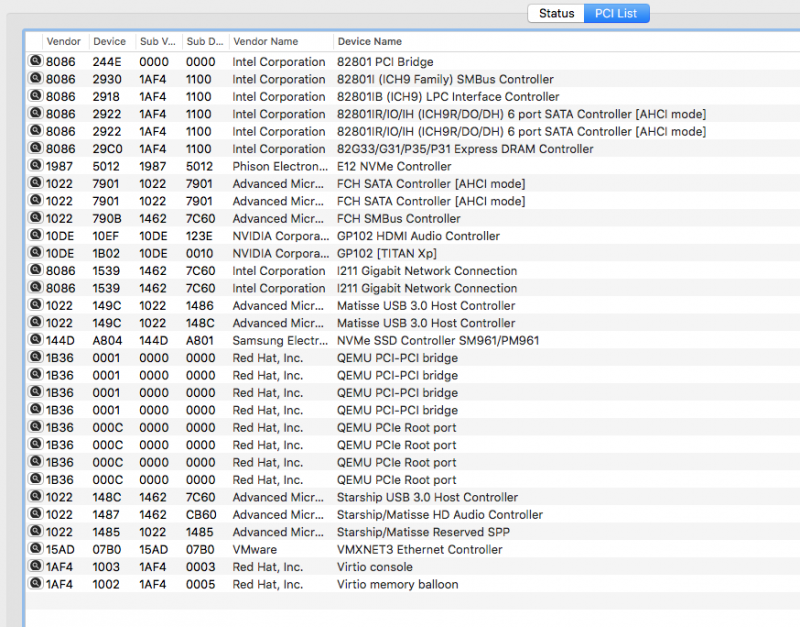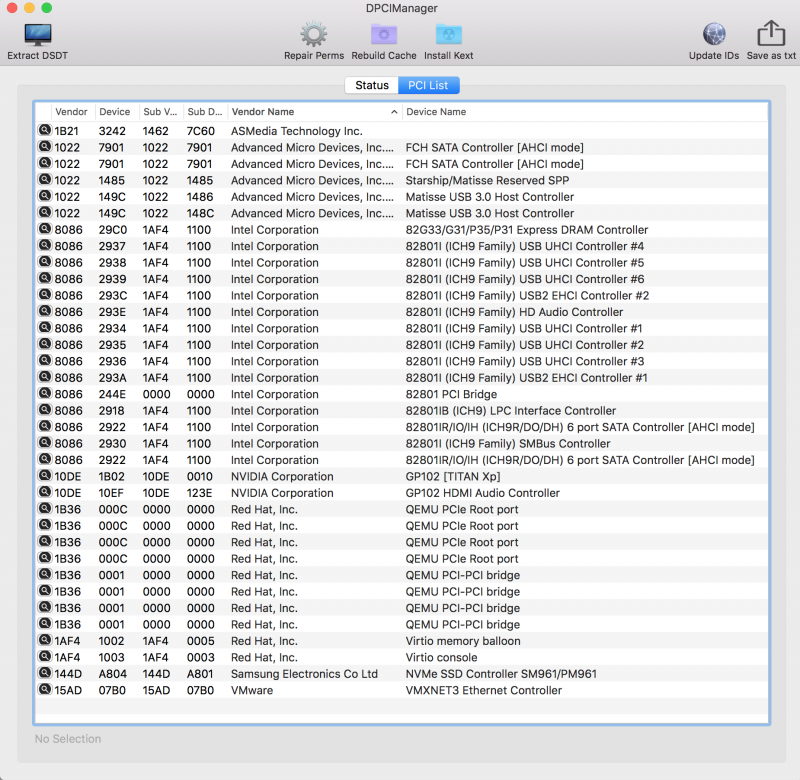Leaderboard
Popular Content
Showing content with the highest reputation on 05/18/2020 in all areas
-
devi provare io posso solo garantirti che da me e da diversi utenti che conosco..la sage ha consentito di avere il miglior hack di sempre come stabilità ed utilizzo poi ogni caso e' differente.. E la variabile negativa e' dietro l'angolo... ma spesso la più' grande variabile siamo noi 🙂 🙂1 point
-
cerca sul forum c'e' una guida sia in italiano che in inglese e' una caratteristica che hanno i sistemi operativi mac bisogna solo attivarla Poi non so se puo' essere comoda anche per te ma esiste da sempre1 point
-
io li leggo e scrivo senza mettere software da sempre... pero' magari a e serve altro... onestamente il problema di Nvram..e' abbastanza simpatica come risposta che ti hanno dato..ma tutto puo' essere 😉 fatti spiegare bene come risolvere magari si impara qualcosa 🙂 questi sopra sono i miei dischi nfs che leggo in OSX1 point
-
1 point
-
mi dispiace qui non so aiutare anche se vedo che hai un software paragon mi pare installato e finche' non hai un sistema solido al 120%..io metterei pochissima roba... pero' ognuno deve fare come crede sia meglio per se 🙂1 point
-
usa un solo ssdt, non 3 per stessa cosa completamente sbagliato... come scritto sopra.1 point
-
Io ero ad esempio un funerale cmq un hub di solito vale una porta poi @Extreme™non rispondi su che problemi hai o pensi di avere quando fai la domanda.. ed è complesso a volte seguire1 point
-
1 point
-
se invece sei su windows puoi usare una live di GParted o PartedMagic la crei manualmente da 200Mb FAT32 con flag boot-esp Con Linux lo fai direttamente con GParted1 point
-
se sei su un macOS basta semplicemente formattarla con utility disco in GPT UEFI poi fai installazione ad hoc di clover indirizzandola sulla pendrive e selezioni legacy o UEFI a seconda del sistema1 point
-
Procedura di flash della rete appena eseguita con successo! 😁 @Gengik84 capo, puoi ceccare your PM? Grazie!🤣1 point
-
Yes, works. I have Asrock TRX40 Creator and Radeon VII. Need to work around the GPU reset bug though. (If you stop the VM and start again the Radeon VII will not initialise, need to reboot the host) I found a working trick with a start hookscript: (this will briefly stand-by the host before starting the VM and it works to reset the GPU) root@ryzen:/var/lib/vz/snippets# more reset-gpu.pl #!/usr/bin/perl # Hook script for PVE guests to reset AMD GPU before VM start # qm set 100 -hookscript local:snippets/reset-gpu.pl use strict; use warnings; print “HOOK: ” . join(‘ ‘, @ARGV). “\n”; # First argument is the vmid my $vmid = shift; # Second argument is the phase my $phase = shift; if ($phase eq ‘pre-start’) { print “HOOK: $vmid is stopped.\n”; system(“rtcwake -m mem -s 3”); } else { print “HOOK: got unknown phase ‘$phase’\n”; } exit(0);1 point
-
1 point
-
Ciao, io quando tentai di installare Mojave con Clover sono impazzito per giorni ed alla fine era proprio l'SSD NVMe il problema, era un samsung 970 evo, e quindi lo cambiai con il pro che non da problemi. Comunque nella guida di OpenCore c'è qualcosa a riguardo ma non ricordo dove perché ho essedo il 970 pro compatibile nativamente non ho dovuto fare nulla.1 point
-
I would like to share something that could be useful for Full PCi tab lovers in about my Mac / System Report /PCI from Proxmox shell (this naming for path is for latest 6.2 proxmox VE installation: nano /usr/share/qemu-server/pve-q35-4.0.cfg you will see: GNU nano 3.2 /usr/share/qemu-server/pve-q35-4.0.cfg #[device "ehci"] # driver = "ich9-usb-ehci1" # multifunction = "on" # bus = "pcie.0" # addr = "1d.7" #[device "uhci-1"] # driver = "ich9-usb-uhci1" # multifunction = "on" # bus = "pcie.0" # addr = "1d.0" # masterbus = "ehci.0" # firstport = "0" #[device "uhci-2"] # driver = "ich9-usb-uhci2" # multifunction = "on" # bus = "pcie.0" # addr = "1d.1" # masterbus = "ehci.0" # firstport = "2" #[device "uhci-3"] # driver = "ich9-usb-uhci3" # multifunction = "on" # bus = "pcie.0" # addr = "1d.2" # masterbus = "ehci.0" # firstport = "4" #[device "ehci-2"] # driver = "ich9-usb-ehci2" # multifunction = "on" # bus = "pcie.0" # addr = "1a.7" #[device "uhci-4"] # driver = "ich9-usb-uhci4" # multifunction = "on" # bus = "pcie.0" # addr = "1a.0" # masterbus = "ehci-2.0" # firstport = "0" #[device "uhci-5"] # driver = "ich9-usb-uhci5" # multifunction = "on" # bus = "pcie.0" # addr = "1a.1" # masterbus = "ehci-2.0" # firstport = "2" #[device "uhci-6"] # driver = "ich9-usb-uhci6" # multifunction = "on" # bus = "pcie.0" # addr = "1a.2" # masterbus = "ehci-2.0" # firstport = "4" # FIXME: Remove this audio0 device at the next possible time # see: https://pve.proxmox.com/pipermail/pve-devel/2019-July/038417.html # https://pve.proxmox.com/pipermail/pve-devel/2019-July/038428.html #[device "audio0"] # driver = "ich9-intel-hda" # bus = "pcie.0" # addr = "1b.0" [device "ich9-pcie-port-1"] driver = "pcie-root-port" x-speed = "16" x-width = "32" multifunction = "on" bus = "pcie.0" addr = "1c.0" port = "1" chassis = "1" [device "ich9-pcie-port-2"] driver = "pcie-root-port" x-speed = "16" x-width = "32" multifunction = "on" bus = "pcie.0" addr = "1c.1" port = "2" chassis = "2" [device "ich9-pcie-port-3"] driver = "pcie-root-port" x-speed = "16" x-width = "32" multifunction = "on" bus = "pcie.0" addr = "1c.2" port = "3" chassis = "3" [device "ich9-pcie-port-4"] driver = "pcie-root-port" x-speed = "16" x-width = "32" multifunction = "on" bus = "pcie.0" addr = "1c.3" port = "4" chassis = "4" ## # Example PCIe switch with two downstream ports # #[device "pcie-switch-upstream-port-1"] # driver = "x3130-upstream" # bus = "ich9-pcie-port-4" # addr = "00.0" # #[device "pcie-switch-downstream-port-1-1"] # driver = "xio3130-downstream" # multifunction = "on" # bus = "pcie-switch-upstream-port-1" # addr = "00.0" # port = "1" # chassis = "5" # #[device "pcie-switch-downstream-port-1-2"] # driver = "xio3130-downstream" # multifunction = "on" # bus = "pcie-switch-upstream-port-1" # addr = "00.1" # port = "1" # chassis = "6" [device "pcidmi"] driver = "i82801b11-bridge" bus = "pcie.0" addr = "1e.0" [device "pci.0"] driver = "pci-bridge" bus = "pcidmi" addr = "1.0" chassis_nr = "1" [device "pci.1"] driver = "pci-bridge" bus = "pcidmi" addr = "2.0" chassis_nr = "2" [device "pci.2"] driver = "pci-bridge" bus = "pcidmi" addr = "3.0" chassis_nr = "3" [device "pci.3"] driver = "pci-bridge" bus = "pcidmi" addr = "4.0" chassis_nr = "4" In there I commented many lines (old USB related) , this to have a better and clean situation in PCI device output in app like dpcimanager or Hackintool My tries it is always related to acquire a perfect functionality on internal audio I miss 😉 with this emu vm config I achieve this: so a bunch of EHCI and UHCI device are not loaded anymore in my system..and functionality of it seems to be the same. From picture above you can see some stuff also passed from the pve-q35-4.0.cfg file, I mean QEMU PCI-Pci bridge.. I am trying if is possible to avoid also some of this loading.You see also other stuff (first 6 lines) it seems not present in this file.. Main task/goal could be to inject here some devices we have in our rig? We will see Previous situation without commenting those lines: here less controllers passed..it is a VM I use to test so I pass few devices! DO NOT DO IT IF YOU PASS USB MOUSE OR KEYBOARD OR OTHER DEVICE AS A SINGLE USB IN WEB INTERFACE1 point
-
OC EFI Maker è spettacolare. Se posso permettermi però, lo script dovrebbe chiedere la cartella di destinazione e non tenere conto della cartella home utente perchè non sempre è /Users/nome_utente Io ad esempio ho la cartella utente un una partizione di un volume quindi il mio desktop del mio utente è in /Volumes/nomeHDD, ho risolto creando una cartella /Users/nome/Desktop1 point
-
0 points
-
@netgear Partition Management è una utility a se' o è inclusa in qualche applicativo?0 points
-
Grazie mille, walterino, per avermi pensato. Purtroppo il mio vecchio desktop ha tirato le cuoia e ho venduto i pezzi superstiti, compresa la Nvidia. Ho assemblato un desktop nuovo con ryzen 5 2400G, senza la scheda video dedicata, cosa che mi ha costretto ad abbandonare l'hack, che era una passione, ma non mi serviva a livello professionale. Continuo a spulciare il sito, più per affetto verso la comunità che per altro, ma mi sono reso conto che il divario tra gli ultimi sviluppi e quello a cui ero rimasto è così grande che riesco a fatica a seguire i discorsi. Comunque spero sempre in una compatibilità futura della integrata AMD, al che riprenderò in mano l'hack, anche se poi dovrò iniziare da zero, ad esempio con opencore. Ciao e approfitto per un abbraccione virtuale a tutti. 😉0 points










